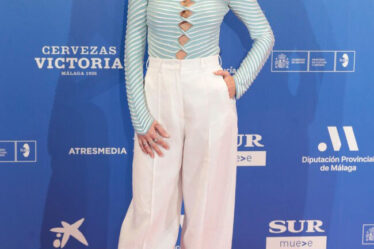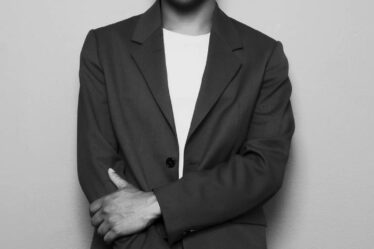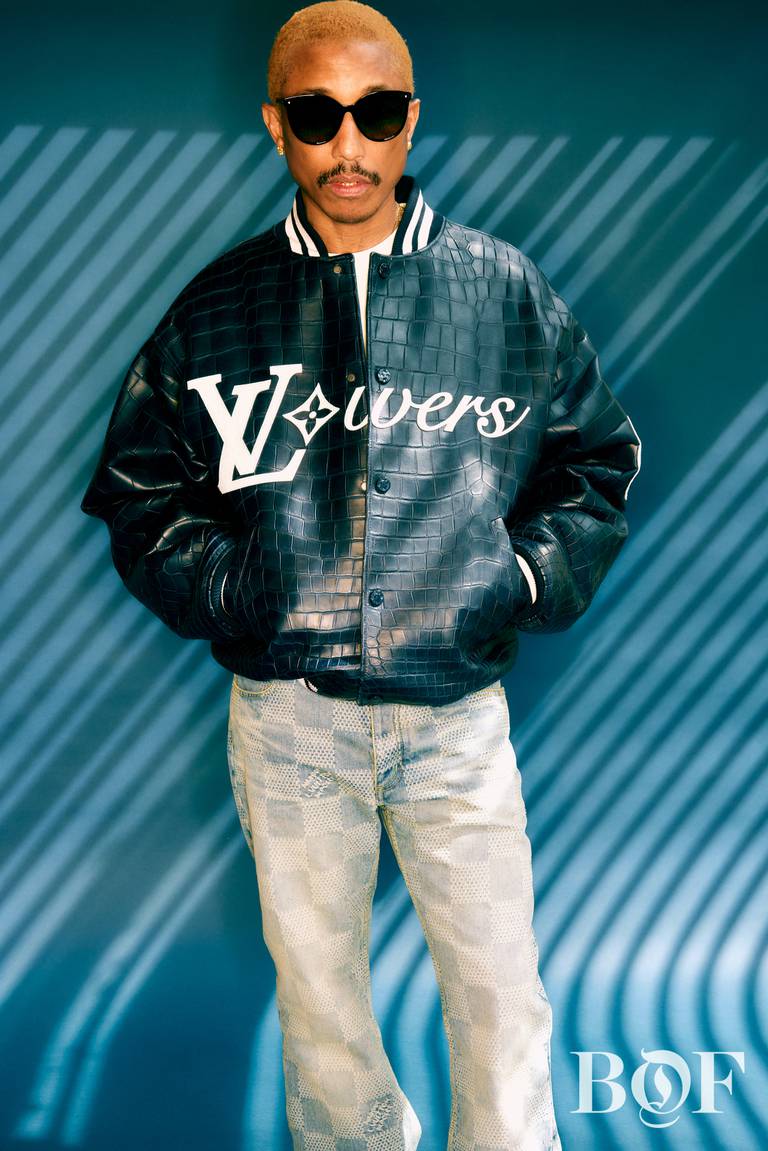
PARIS — For Pharrell Williams, the future of luxury is “freedom.” Not a bag, not a logo. Freedom.
I’m in Paris to meet Louis Vuitton’s new men’s creative director on the first day of September, outside the hype cycle of fashion week. Paris is just waking up from its August slumber, the air still thick with humidity.
Pharrell enters a small, quiet room in the Louis Vuitton headquarters. He is zen-like and greets me with a head bow, his hands clasped together, a bit like an Indian namaste. He’s more subdued than the last time we met at a ‘Friendsgiving’ dinner in London last November to mark the UK launch of Humanrace, the skincare line he launched in 2020. That night, he spoke passionately about US politics, his life in Miami and Kanye West.
But that was a conversation from another time, before Pharrell’s appointment as Louis Vuitton’s men’s creative director changed his life, turning the multi-hyphenate celebrity singer, producer and entrepreneur from the American South into one of the most visible figures in the global luxury industry.
The Vuitton role had been vacant since November 2021 following the sudden death of Virgil Abloh, who broke racial barriers when he became one of luxury fashion’s first Black creative directors in March 2018. Many fashion insiders had sniffed at Abloh’s collections, but season by season he won people over by opening up Vuitton — and the wider luxury business — to a broader audience of people, once overlooked by the industry, using narrative devices like “The Wizard of Oz” to extend Vuitton’s heritage in travel to another kind of journey: social mobility.
With the baton now passed to Pharrell, the second Black man to lead menswear at Vuitton, I was keen to hear how he would leave his imprint on the LVMH-owned house and luxury writ large.
What is luxury according to Pharrell? And what does it all mean for his vision for Louis Vuitton, the world’s first €20-billion luxury brand?
From Virginia Beach to Global Style Star
But first I want to understand more about how Pharrell’s relationship with fashion first began, growing up in Virginia Beach in the 1980s, far from the fashion capitals and long before the internet made fashion culture ubiquitous.
“I mean I definitely came from very modest means, so I didn’t learn what Gucci was until I started seeing what the rappers were wearing in their videos, made by Dapper Dan — and of course, the Vuitton stuff as well,” he begins. “I didn’t know what none of that was until then, because that stuff didn’t make it to us. It wasn’t in a twenty mile radius of where I lived.”
“But that didn’t stop us from feeling and sensing it when we saw it on television,” he continues. “You knew it was dependent on the person — and the way that they carried themselves and their attitudes. You would know, okay there’s something up with that fit, that jacket or those shoes. It was the personalities that first convinced you it was cool.”
Now, Pharrell is one of those cultural heroes, known around the world not only for producing scores of songs for the world’s top musical artists and his Grammy-winning hip hop, R&B and pop music tracks, but for his personal sense of style, which has morphed over the years from baseball caps and graphic t-shirts to sharp tailoring with flamboyant flourishes and stand-out accessories.
Pharrell first entered the cultural consciousness in the early 2000s, when he and Chad Hugo, a duo known as The Neptunes, wrote and produced a string of era-defining anthems like ‘Beautiful’ and ‘Drop it Like It’s Hot’ with Snoop Dogg, ‘Senorita’ and ‘Rock Your Body’ with Justin Timberlake, ‘I’m a Slave 4 U’ with Britney Spears and ‘Milkshake’ with Kelis.’
But his interest in fashion soon attracted attention, too. In 2003, he co-founded Billionaire Boys Club with the godfather of Japanese streetwear, Nigo. At the time, Pharrell began venturing into high fashion, becoming more directional with his choices. The same year, he met Marc Jacobs who asked him to design sunglasses for Louis Vuitton. One of these designs, known as “The Millionaires” — are still in demand on resale sites with asking prices starting at $1500 — (Abloh, for his debut show, created his own version of the glasses, dubbed The 1.1 Millionaires, which are still sold by Vuitton today.)
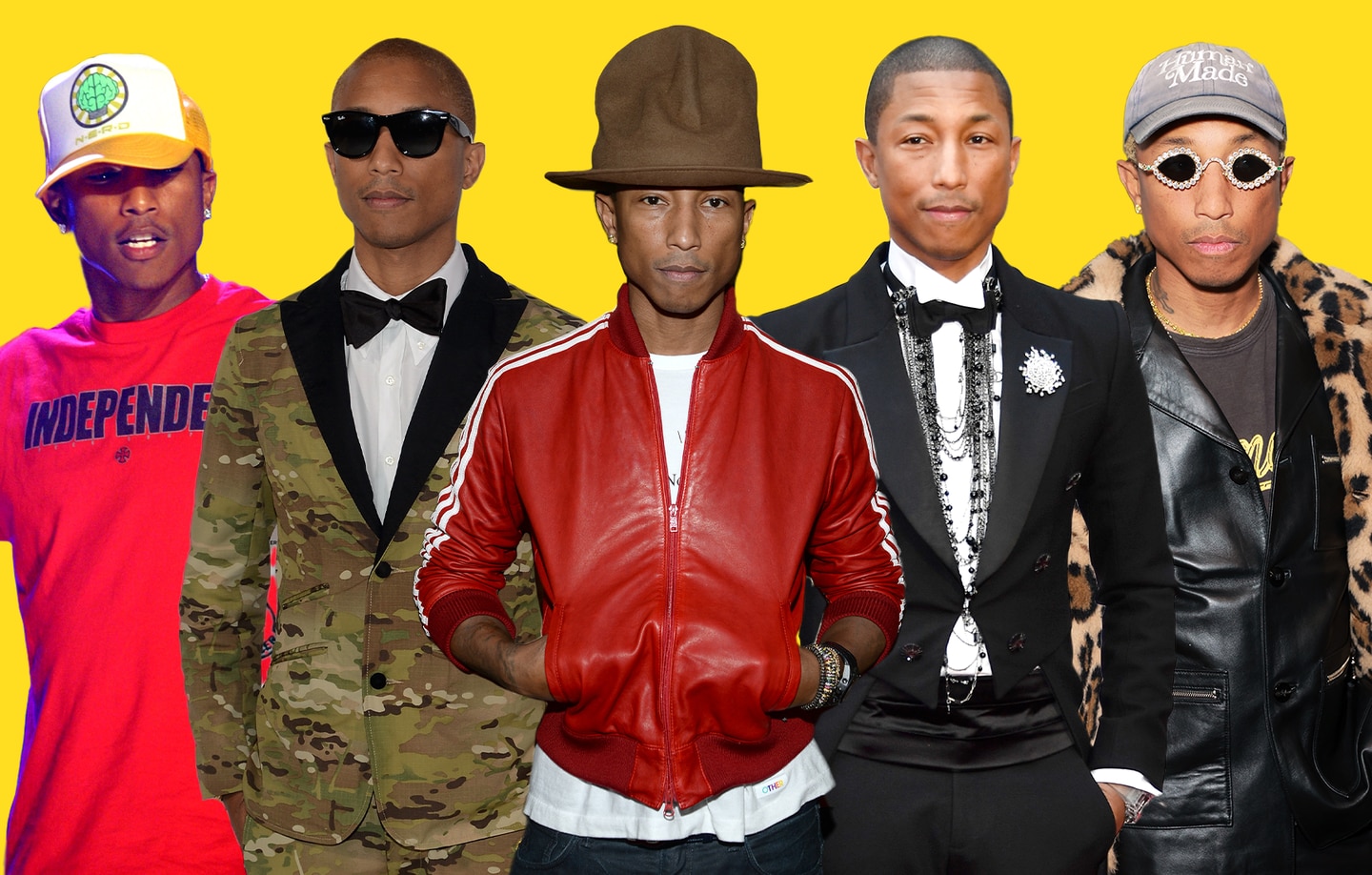
By the time his hit song ‘Get Lucky’ with electro-pop duo Daft Punk peaked at number one on the UK singles charts ten years later, he was a fashion trendsetter, frequently seen donning a remake of an oversized Vivienne Westwood Buffalo hat, which became a style signature of his for more than a year.
By 2015 — the year after his solo track ‘Happy’ hit number one in 24 countries, was awarded a Grammy for Best Music Video, and became the most downloaded song of all time — Pharrell’s high fashion cred was validated when Karl Lagerfeld cast him as the first man to be featured in a major Chanel campaign, appearing alongside model-of-the-moment Cara Delevingne. Soon, the likes of Adidas, Tiffany and Moncler were all banking on his personal style and global celebrity to fuel their marketing.
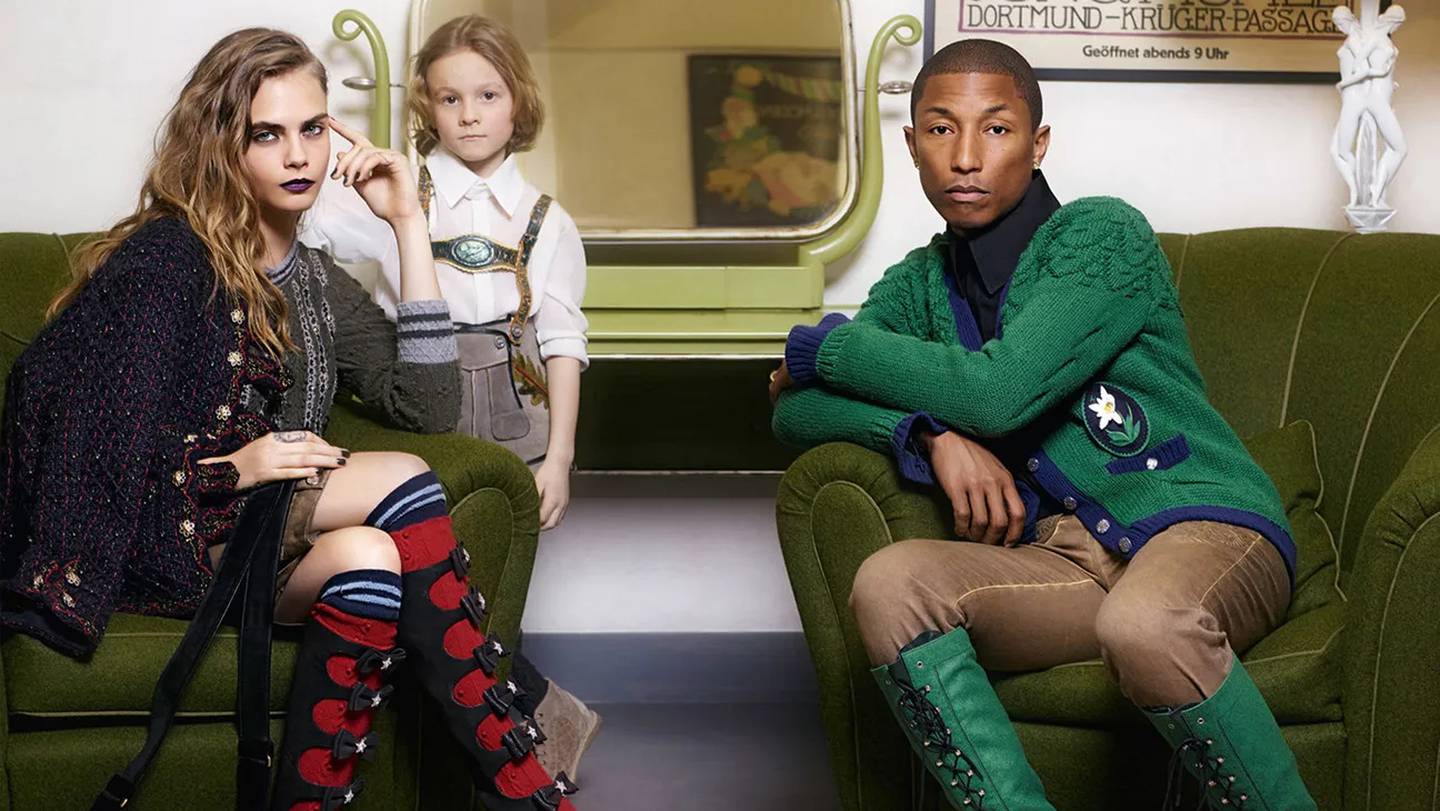
But the hotly debated question inside fashion circles ever since Pharrell’s Louis Vuitton appointment was announced in February is whether his star power and sense of style would be enough to guide the creative direction of the world’s largest luxury goods house at a time of great change for the sector.
Luxury at a Crossroads
If Pharrell, and Abloh before him, seemed unexpected choices to lead a key division of a luxury goods megabrand, their journeys from humble beginnings to what Abloh called “the Emerald City” of Paris, bear at least some resemblance to the journey undertaken by Monsieur Louis Vuitton himself, current and former executives at the company say.
In 1837, a 13-year-old Louis Vuitton left Anchay, a rural village near the Jura mountains in eastern France to make the almost 300 mile journey to Paris by foot. The trip took him nearly two years. Along the way, he did odd jobs to make ends meet. At night, he slept outdoors.
When he arrived in Paris, the capital was undergoing a period of radical societal and political upheaval. The French Revolution of 1789 had given rise to waves of widespread protest, as the country alternated between republic and monarchy.
Shortly after arriving in Paris, Vuitton started apprenticing at the workshop of Monsieur Maréchal, who specialised in the creation of bespoke trunks for the French elite who had started to travel internationally. In 1854, Vuitton set up his own workshop at 4 rue neuve-des-capucines near the Place Vendome, still Paris’ symbolic centre of luxury which gave rise to the luxury lifestyle we know today.
The sprawling LVMH group, made up of more than 70 brands including Louis Vuitton, is run by Bernard Arnault, the world’s first or second richest man depending on what is going on with the company’s stock price and what is happening with his mercurial rival for the top of the rich list, Elon Musk.
The two billionaires broke the internet over the summer when they posed for a photo on the balcony of Arnault’s Cheval Blanc hotel, at the foot of Pont Neuf, the oldest standing bridge that runs across the river Seine. Across the street, and all around, are Louis Vuitton offices and studios. Over the summer, just outside the main entrance, a huge statue of Yayoi Kusama to mark her second collaboration with the house became an instant tourist attraction, and was featured in a gazillion Instagram posts.
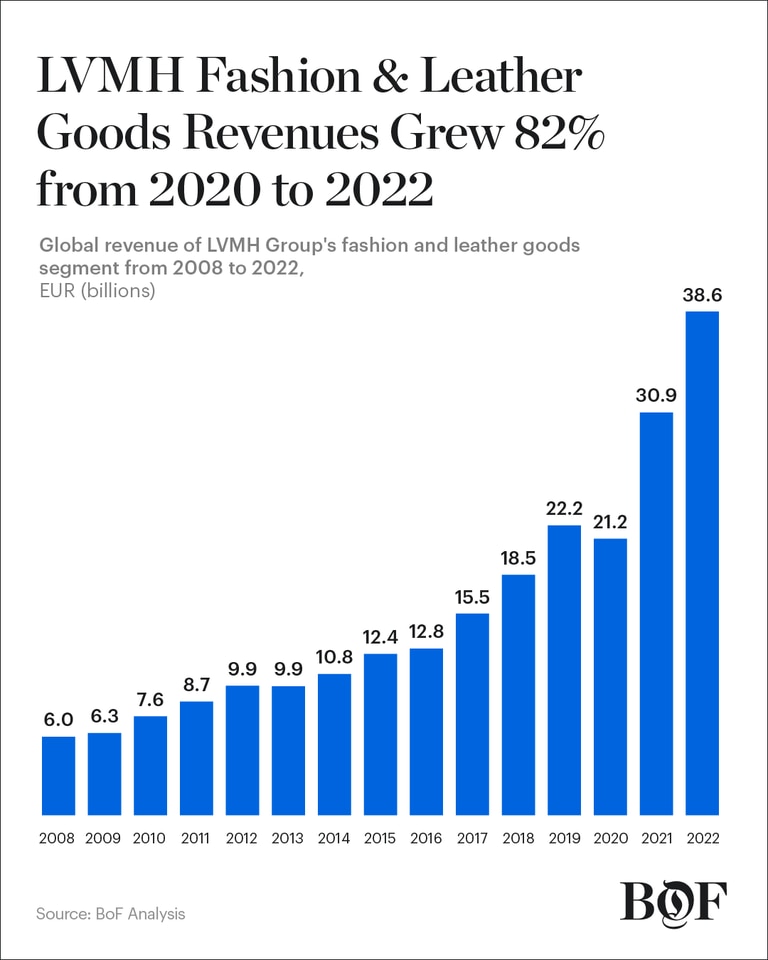
LVMH does not break out revenues of individual brands, but reported annual revenues of the fashion and leather goods division of LVMH grew an astonishing 82 percent between 2020 and 2022 to €38.6 billion. Louis Vuitton accounts for more than €20 billion in revenues, or about half of LVMH’s fashion and leather goods group sales, and according to analysts, about half of the group’s overall profits. It is, in other words, the all-important cash cow of LVMH — and a bellwether for the entire luxury sector which has boomed during the pandemic.
But following the 15 to 20 percent annual growth rates of the market over the last two years, the luxury sector’s growth rates are coming back to earth as aspirational luxury shoppers — especially in the United States — are tightening spending. Analysts expect that luxury market growth rates will return closer to the long-term average of 5 to 6 percent for the foreseeable future.
Meanwhile, France is again in the midst of an intense public debate about inequality and the changes required in longstanding systems, structures and beliefs of how a modern day society should work and not everyone in France admires Mr. Arnault’s ambitious empire building. For a few brief minutes, protestors upset with pension reforms brought in by President Emmanuel Macron, even stormed the LVMH headquarters on April 10.
“For the first time in France, where there is nothing above the state, a private individual is more powerful than the king,” economist and philosopher Jérôme Batout told the French newspaper Le Monde in August.
A Big Bang on Pont Neuf
It was with this national debate raging and growing uncertainty in the luxury sector that the multi-hyphenate cultural supremo Pharrell Williams relocated his family to Paris. Just four months after his appointment, Pharrell staged his first show as the Louis Vuitton hype machine went into overdrive.
Top luxury fashion brands now spend around 5 percent of their revenues on marketing. For Vuitton, that means a marketing budget of more than €1 billion per year. For Pharrell’s big debut, LVMH had, at no small expense and bureaucratic complication, convinced the authorities to shut down the city’s cherished Pont Neuf bridge near its headquarters, leaving some locals less than amused.
In an unprecedented display of LVMH’s corporate power, the cobblestones on the bridge were covered in a gold version of the house’s signature checkerboard damier pattern. Nineteen hundred invited guests arrived – many, including myself, by bateau mouche – just as the sun was setting on the river Seine. En route, we passed a towering version of Pharrell’s first ad campaign featuring a heavily pregnant Rihanna carrying armfuls of colourful Speedy bags.
The author has shared an Instagram Post.You will need to accept and consent to the use of cookies and similar technologies by our third-party partners (including: YouTube, Instagram or Twitter), in order to view embedded content in this article and others you may visit in future.
Before the show started, I scanned the long front row of names written on the sleek folders containing gold rain ponchos in case the weather didn’t cooperate. They reflected every aspect of culture in music, entertainment, sports — from all around the world.
“Monsieur J.Balvin” (Colombia), “Monsieur Jackson Wang” (China), “Monsieur Skepta” (UK), “Mademoiselle Anitta” (Brazil), “Monsieur Lewis Hamilton” (UK) and of course a string of American stars, including Rihanna, ASAP Rocky, Beyoncé, Jay-Z, Zendaya and Kim Kardashian. They were all coming.
The industry had never before seen such a powerful assemblage of global celebrities at a fashion show. The mere presence of these stars would amplify the show into the stratosphere.
But beyond the bold-faced names, there was also a contingent of more behind-the-scenes players shaping culture today. I bumped into June Ambrose, the stylist who was instrumental in matching hip hop and R&B artists with fashion brands in the 1990s; Darnell Strom, the power agent at UTA who represents Edward Enninful and Michaela Coel; and the power publicist Desiree Gruber, whose firm represents the Kardashian industrial complex. It seemed like every relevant cultural figure was on the ground for the show.
Only the combined Vuitton-Pharrell power vortex could draw such a crowd. Luxury’s hybridisation with celebrity and hip-hop culture has been key to its staggering sales expansion, and Pharrell’s debut took that strategy to a whole new level. It was the ultimate flex of cultural clout and social media muscle.
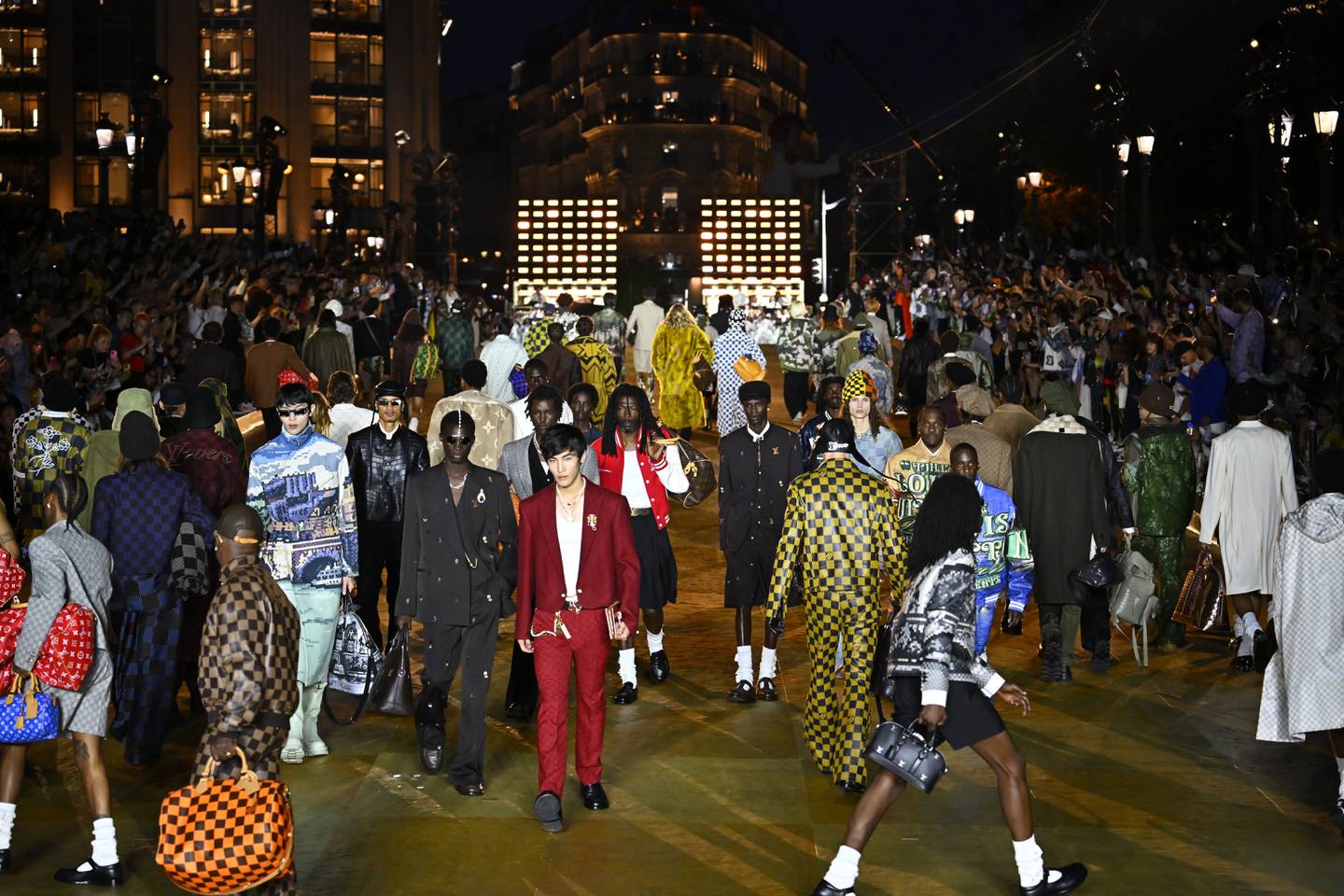
Much of Pharrell’s first collection riffed on the damier, which he had blown up, pixelated and placed onto jackets, trousers and leather goods. He transformed his old go-to camouflage style staple into something he called the damoflage and reimagined the house’s best-selling Speedy Bag in luscious buttery leather replacing the standard coated canvas. And, unusually for a brand that also has a dedicated womenswear designed by Nicolas Ghesquiere, Pharrell cast several women in his show, including Liya Kebede, Anna Ewers and Anok Yai.
Afterwards, a BoF Instagram post summarising my post-show interview with Vuitton CEO, Pietro Beccari, elicited a flurry of comments capturing the online mood.
“We are living in an era of Fash-O-Celeb where cultural capital rules supreme. I wonder if logo saturation and great styling is enough to sustain a vision?” wrote Zara Korutz, a PhD candidate at New Zealand’s Massey University in an Instagram comment that was the most liked by other followers. “Personally, I prefer a strong dialogue that moves me emotionally with intellect rather than relying on the allure of bling and star power.”
But others pointed out that Pharrell has been working in and collaborating with the fashion industry for years. “I think all the naysayers here in these comments don’t know Pharrell’s history in fashion,” wrote Ronald Nixon, a self-described fashion lover and designer. “He created Billionaire Boys Club and partnered with many other houses including LV in the past [and] also studied with Karl Lagerfeld. So … he is famous for a reason. He is multi-talented. Don’t put people in a box.”
Fashion critics tried to make sense of the debut too. “He unquestionably has many of the skills, perhaps the most important skills — showmanship, team building — for a fashion creative director,” wrote Cathy Horyn, the former New York Times fashion critic who now writes for New York Magazine’s The Cut. “But he needs something more. Call it audacity.”
Horyn called the show “a display of brand power and money without special artistry,” concluding that “the fashion industry has all but abandoned design talent.”
Ten days after the show, Vuitton confirmed that the show had received more than 1 billion online views — 775 million on its own accounts and 300 million on press accounts, setting a record for the reach of a single fashion show. (Vuitton declined to disclose more up to date figures, but as a point of comparison, Pharrell’s show has more than 16 million views on Youtube, at the time of writing, while Virgil Abloh’s debut show from June 2018 has just under one million views.)
Clearly that was the main point. For a brand at the scale of Louis Vuitton and still targeting rapid growth, a creative director with a large community of online fans, no shortage of celebrity friends, and reach across cultural spheres far beyond fashion, will give the brand further visibility that a more traditional designer would find impossible to match.
“Over the past two decades, fashion and popular culture have come to feel interchangeable, but this was a new degree of closeness,” wrote Rachel Tashjian, a fashion writer at the Washington Post. “An idea or designer no longer toils as a niche fascination, with a famous musician or powerful editor sometimes making them a star. Everything is for everyone, right away. The celebrity is no longer the person reflecting a culture’s values but creating them.”
“It’s a very clear exemplification [that] fashion is becoming music, becoming pop culture, becoming a spectacle itself,” says Louis Vuitton CEO Pietro Beccari, reflecting on the Pont Neuf extravaganza. “This is part of not wanting just to buy a product and offering an experience and becoming culturally relevant.”
The Logic Behind LVMH’s Pharrell Pick
Virgil Abloh’s death came as a shock. LVMH insiders vigorously debated for more than a year who could possibly step into his shoes. A number of names were considered, among them the talented London-based menswear designers Martine Rose and Grace Wales Bonner, and KidSuper’s Colm Dillane who had been asked — in what amounted to a quasi-audition — to stage a one-off men’s fashion show by former Louis Vuitton CEO Michael Burke. (It was Burke who had overseen the appointment of Virgil Abloh and who managed the shock to the Louis Vuitton system after he died.)
But it was Pharrell who rose to the top, and at first, even he didn’t quite understand why.
“I mean, weren’t you surprised when you heard it?” he asks me. “I just was advocating for my brother [Nigo] and I just hadn’t even considered myself in that way,” he says, referencing his longtime fashion mentor and co-conspirator who is now creative director of Kenzo, another LVMH-owned brand.
“That’s why this whole thing has just been so mind blowing. I’ve just been so touched by the whole thing … that someone would see me that way. But then there are certain parts within you that you know were there, but you’re just not even thinking about it in that way.”
“It was all pretty organic,” recalls Alexandre Arnault, the eldest of Bernard Arnault’s three sons from his second marriage, who helped broker the deal. Alexandre has gradually gained more influence in top-level decision making since he started working at the group ten years ago.
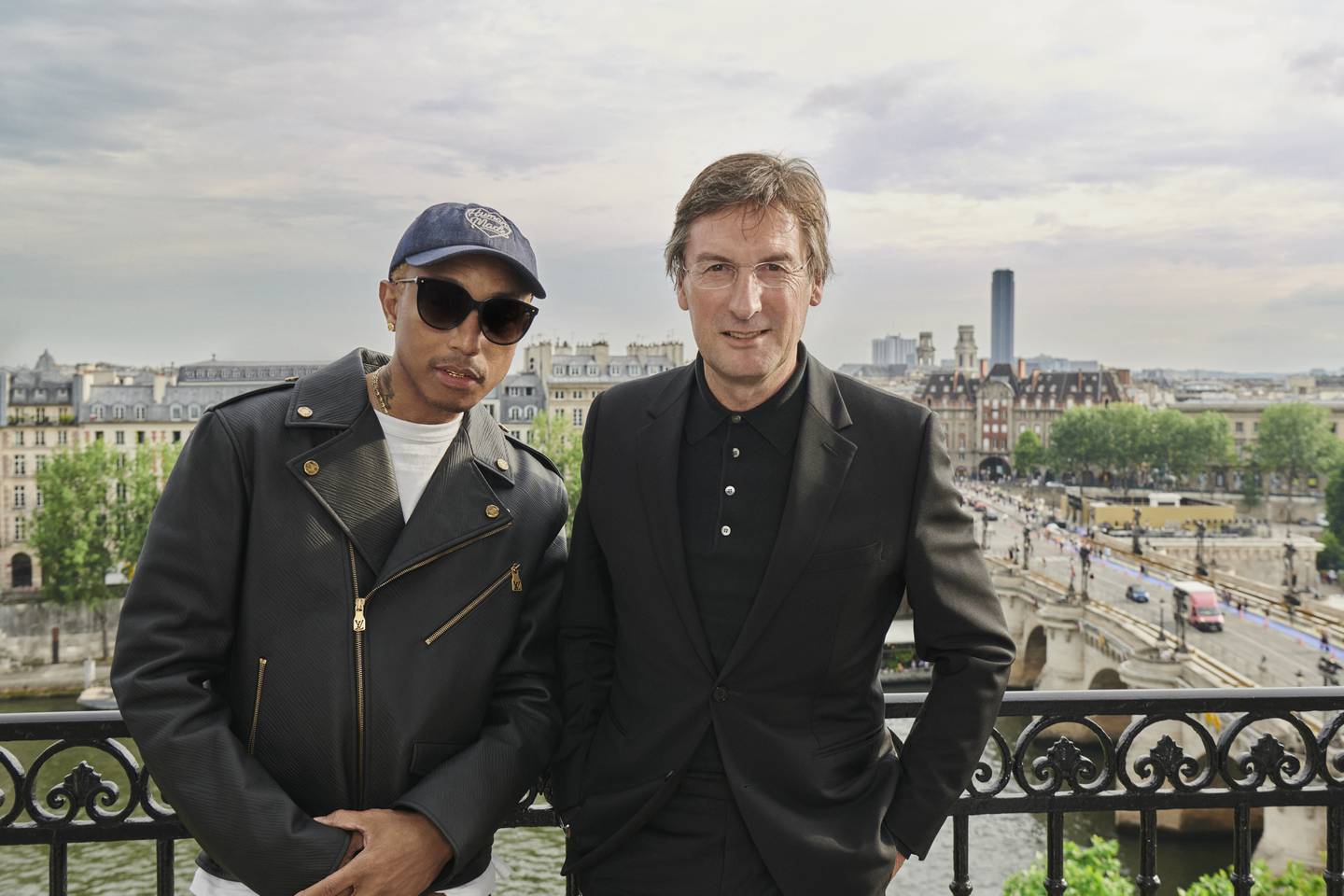
“Pietro had the idea of asking him, not knowing if it was something that would interest him at all, given his life and music and Miami and everything. But from a little over a decade of conversations with Pharrell, I knew he would be interested. So I made the call to him and asked him officially. He replied within 24 hours and said ‘Let’s do it’.”
The idea of who would be a suitable replacement for Abloh appears to have changed directions amid the CEO transition at Louis Vuitton. After Burke announced he would step back, it was Becarri who was tapped by Arnault to step up. He first posited the idea of offering Pharrell the role in December 2022, before he officially took on the role of CEO of Louis Vuitton.
“Of course, I thought about appointing an incredible designer to succeed Virgil — but I needed someone who could really step into Virgil’s shoes,” Beccari explained to me a few days after the show. “Pharrell is similar to Virgil. He is in touch with so many worlds. We have long moved beyond fabricating and selling products. We produce books, we sponsor sports. Virgil understood this, and who better than Pharrell to take his place?”
Like Abloh, Pharrell is not a trained designer. He is doing something he has never done before — designing an entire collection of clothes, bags, accessories, developing global ad campaigns, orchestrating fashion shows and leading a studio team of more than 50 people — for the biggest luxury brand on the planet.
But in the age of social media marketing, a creative director in fashion today is not someone who solely designs collections and develops campaigns. Multibillion dollar megabrands like Louis Vuitton also require someone who can create dialogue with customers and who can communicate a vision they can understand and buy into, something that Abloh was supremely talented at doing.
“I didn’t know Virgil so well but, when we did meet, he gave me the same sense of authenticity [as Pharrell],” Beccari tells me a few months later when asked to explain further why he feels Pharrell is Virgil’s natural successor. “What we feel around him is real positive energy and that people love him. I had the same sensation when I was with Virgil.”
Beccari was also convinced by Pharrell’s humility and work ethic. “I saw how dedicated he was to learning the savoir-faire, his immense curiosity, his grasp of the mechanism of a company. I saw a guy who was willing to go the extra mile.”
What has changed since in recent years is the degree of commingling between fashion and other cultural spheres, the visibility of the fashion industry propelled by social media — and the amount of money fashion companies like Vuitton are willing to spend to create awareness of their brands and products. Last year, advertising and promotional spend at the LVMH group increased by 25 percent overall to more than €9.5 billion.
“He sits at the crossroads of fashion, music and art, which not many people do the way he does,” says Alexandre Arnault
Since celebrities with big followings have media channels of their own, Pharrell has a built-in advantage. The only designer that comes close to his 15 million Instagram followers is Balmain’s Olivier Rousteing, with almost 10 million followers. Some observers are convinced that the main reason Pharrell was chosen was to drive this hype machine with all his celebrity friends, something that Alexandre Arnault says does not give the full picture.
“We’ve had many examples in our group — and within competitors — of fashion designers who had the world’s biggest celebrities come to their fashion shows. But if the product isn’t there, the sales aren’t there, right?” says Arnault.
“Obviously, he’s a great showman. He did something that was unprecedented. But that is not what will be driving the success of the collection or the sales,” he underscores. “To me when the products arrive in the store, at the end of the year or the beginning of next year, then the jury’s out.”
Decoding Pharrell’s First Collection
Menswear is thought to be a small fraction of Louis Vuitton’s more than €20 billion in revenues, but even 15 percent of this would make it the world’s largest luxury menswear business with €3 billion in revenues. (By comparison, the Zegna brand did €1.2 billion in revenue in 2022).
“I made the distinction that I design from a place of what it is that I’m looking for and what I need,” says Pharrell, explaining the vision he laid out for Arnault and Beccari. “And then I talked about the archetype, which is the consumer and the idea that there are essentially five pillars, five modes of the things that we’re looking for.”
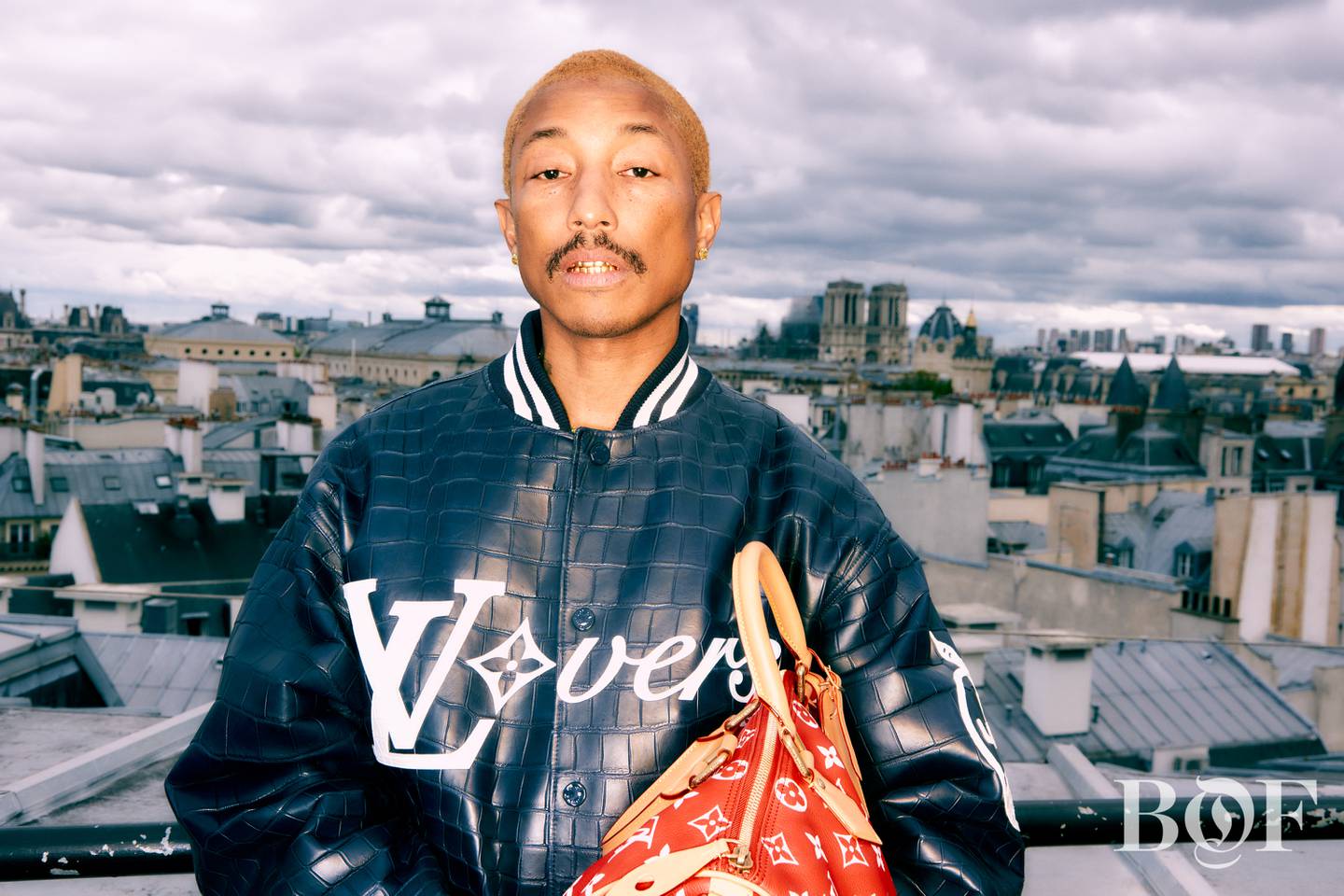
I ask him to be more specific.
“Well, that’s the secret sauce,” he says.
I push again, gently, and he concedes — to a point.
“Well for one of the pillars, it’s like formal, which we refer to as a different name,” he says. “If I have the disposable income to be a regular customer, I’m more than likely going to be someone who owns a business. Someone who’s in a C-suite position of a business. Or someone who works at a business. You’re going to need to take some time to go to events and go to ceremonies. Right? So I’m going to need formal wear. That’s one pillar. There’s four others.”
“We’ve been using terms like dandy, like tailoring, like drapery, things that aren’t necessarily the most on trend right now in fashion, where until very recently you saw a lot of hoodies and logos and cargo pants,” adds Arnault. “He will do the opposite which is really healthy.”
But ultimately, it is the success of the handbags and leather goods where Louis Vuitton’s business lives or dies, and Pharrell’s propositions here were numerous.
The standout item, which also featured in the Rihanna campaign, was the iconic Speedy bag, but in bright colours and buttery leather that give the bags a new appeal.
“I think one of the most famous bags on the planet is the Speedy,” says Pharrell. “But it was also, like, appropriated so crazy and just totally, like, counterfeited, like, beyond. And I think that also helped to make it as big as it is.”
Pharrell’s leather Speedy comes with a price tag of €9,000 (for the medium size), about 3 times more expensive than the same Speedy shape, also from his debut collection, in the damier print but in coated canvas, which will retail at €2,750.
“It’s about the most expensive bag we ever sold for men – not talking about exotics – but regular leather. We will not produce it in big quantities because we want to maintain its exclusivity. But I think that there will be people fighting for it. Yes, I do,” Beccari says.
His confidence may come from the fact that he already has a read on what is resonating with top customers who attended the show.
“We invite customers after the show to something we call a ‘re-see,’ where they have the chance to see the collection that was on the catwalk in real life and touch it – and also all appendixes of this collection – so they can pre-order pieces before the rest of the world — and be lucky enough to receive them 4 to 6 weeks in advance compared to the stores.”
Luxury is ‘Freedom’
Aspiration is a fundamental part of the modern luxury experience, a marker of having arrived, of having succeeded — and more recently, of having overcome systemic obstacles. Much of the growth in the luxury sector has come as a result of new wealth creation that continues around the world.
“We are experiencing an increase in the number of people who can access luxury, to reward themself with a piece of a legendary brand and tell themselves, ‘I made it,’” says Beccari. “Perhaps it’s not something indispensable, but maybe it helps to live a little bit happier or to give you a happy moment. I’m talking about China, but also about other emerging countries like Vietnam, Thailand, Southeast Asia.”
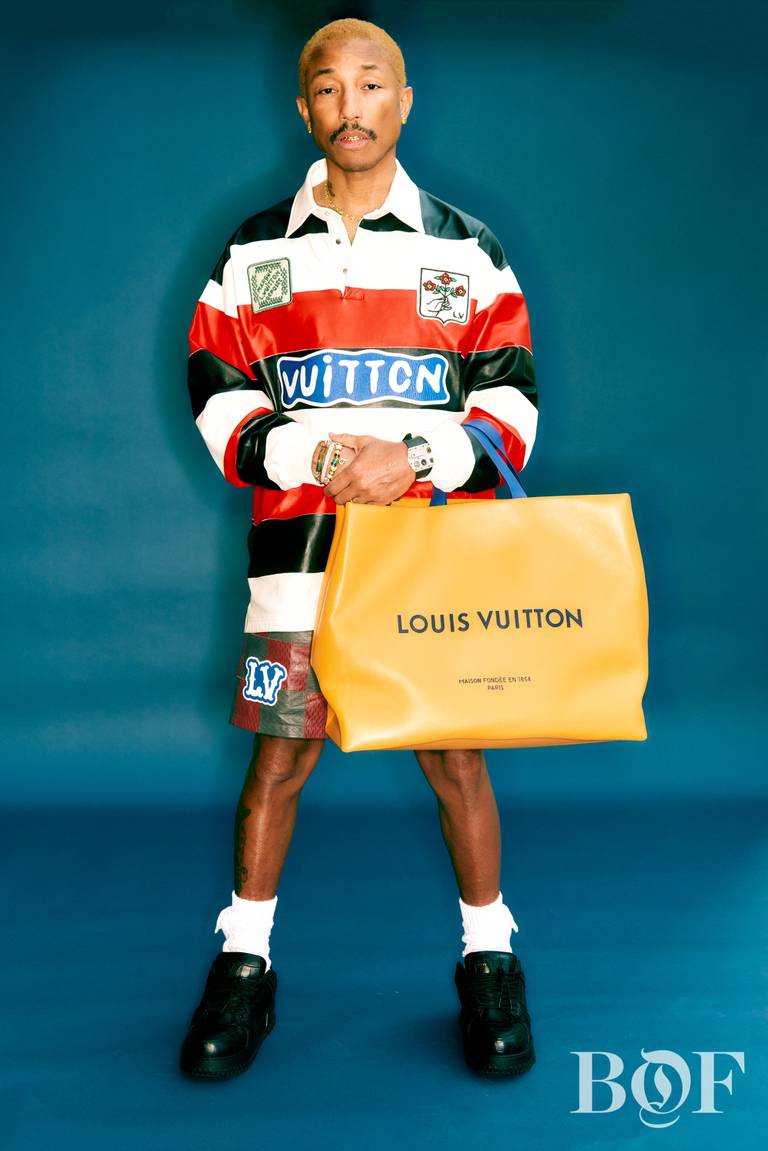
Aspiration is one of the narratives that hip hop stars like Pharrell have told through their music. But through his work at Vuitton, he wants to reframe the notion of what aspiration really means to someone like him.
But Pharrell has his own take on aspiration and its link to luxury.
“When we say the word hip hop or rap and we say aspiration, the first thing most people are trained to think — and what’s been marketed to you — is that that means champagne bottles; that means like superfast foreign cars. And that’s not really what it is,” he explains.
“For me, the aspirations of people who look like me is to be economically free, to be educated, to have equal access to health care, equal access to representation. And like I say, it’s also education first and foremost, so that you have the tools to go build out and live your dreams, whatever they may be. That’s luxury.”
“Freedom is a luxury,” Pharrell exclaims. “Not everybody has freedom. And we want that. And so I try to tell these stories with our seasons and our campaigns and our shows.”
But while the quest for freedom is central to the Black American experience, it is also resonant around the world, from Virginia Beach to a Chinese mega-city coming into its own.
‘I want to tell these stories of what freedom feels like and what it looks like when you’re having the resources and having the support and having the platform to do that. Henry Taylor. First mother, woman with child in a campaign. Black woman.”
Pharrrell is referencing two of his first collaborators. Of course there was Rihanna’s ad campaign. But there were also more subtle Black narratives that you had to look for more assiduously. Such was the case with 65-year-old Black painter Henry Taylor, whose signature portraiture was embroidered into a tailored black jacket and denim, and superimposed on jewellery and cameos atop the damier in Pharrell’s debut collection. Taylor is known for his social commentary on racism, policing and American history.
Finer details like these were lost in the super-mega-over-the-top production of the show on Pont Neuf — and not visible on the livestream view by more than a billion people – but they do underscore that, like his predecessor, Pharrell has a bigger vision in mind than just selling bags and clothes.
“That word freedom is such a heavy word these days. When you look around in certain places on the planet, there’s not a lot of people who are free…from their environments to even their legal systems. So that’s my job with this platform. To tell these stories and to inspire young or old, you can do it. What can’t you do? You can do it, too.”
Those five words were the same five words Virgil Abloh wrote on an Instagram post on the day of his debut Louis Vuitton show in June 2018.
“You know, when Virgil got his appointment, we were all so blown away,” recalls Pharrell “And I was so happy for him. And I told him many times and again, that was enough for me. That was enough for the books. So, you know, going back to your question earlier, when you were asking me why didn’t I think that about myself? Because, man, Virgil, that was enough. It was more than one for the culture. And so, you know, he has giant shoes for one to try to fill. But that’s not what I’m here to do. I’m not here to fill my brother’s shoes. My brother’s shoes are his shoes. And the steps that he took are his steps.”
“What it is that I was brought in here to do is to push expansion and growth not only in sales, but in perspective, culturally,” he goes on. “My culture has been a very significant contributor to the bottom line every quarter. Like, that’s not lost on the house. That’s not lost on the [Arnault] family. That’s not lost on me. So that’s important to us.”
Disclosure: LVMH is part of a group of investors who, together, hold a minority interest in The Business of Fashion. All investors have signed shareholders’ documentation guaranteeing BoF’s complete editorial independence.

